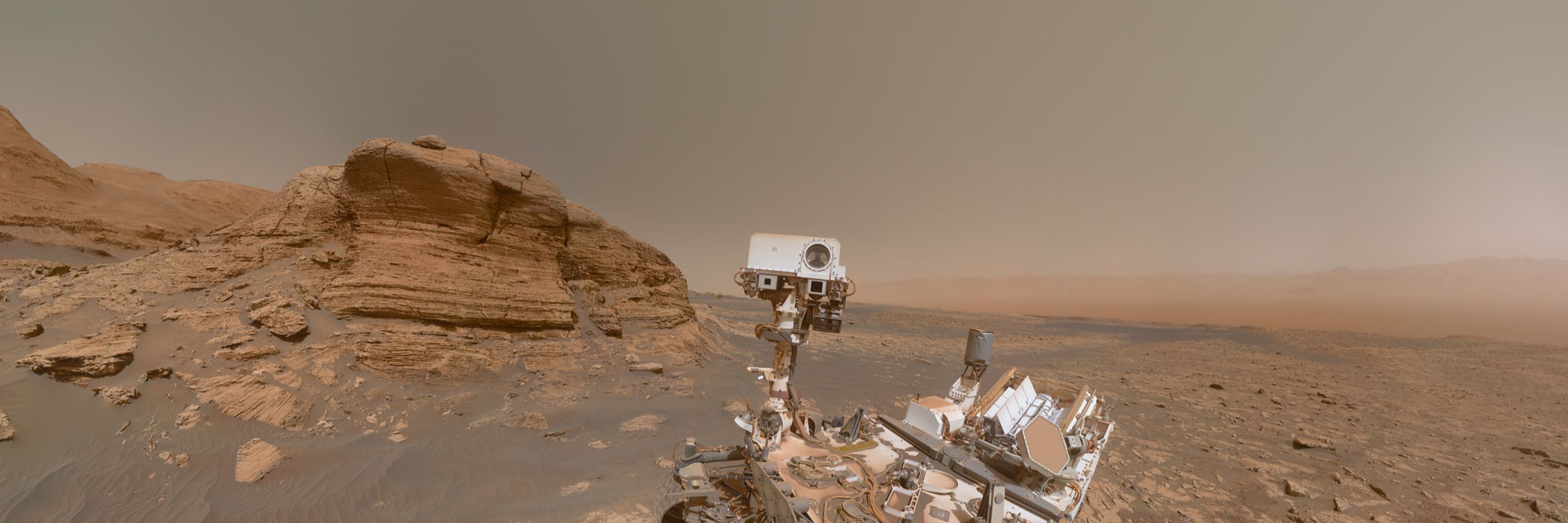
The rover is currently investigating the outer rim of Jezero crater near an outcrop named Sally's Cove. #planetsci
Full panorama: www.360cities.net/image/persev...
Credit: NASA/JPL-Caltech/MSSS/Steve Albers/Simeon Schmauß
Woodruff Narrows, Wyoming

Woodruff Narrows, Wyoming

If you want to propose your favourite planetary science image of 2025, place it below with a link to the source and when it was published.

If you want to propose your favourite planetary science image of 2025, place it below with a link to the source and when it was published.
The Perseverance rover on Mars has serendipitously recorded sounds and electromagnetic signals that are characteristic of lightning in dust storms.
☑️ www.nature.com/articles/d41...
☑️ rdcu.be/eR5lp
#Mars ⚡🔭🧪

The Perseverance rover on Mars has serendipitously recorded sounds and electromagnetic signals that are characteristic of lightning in dust storms.
☑️ www.nature.com/articles/d41...
☑️ rdcu.be/eR5lp
#Mars ⚡🔭🧪
1,881 images from a time-lapse sequence photographed by Don Pettit are repaired, remastered and retimed to create this 3x real time video footage, with music by Hiroshi Yoshimura.
Credit: Don Pettit / ISS / NASA / ESRS / Seán Doran
youtu.be/yDGjtg-_VUA

1,881 images from a time-lapse sequence photographed by Don Pettit are repaired, remastered and retimed to create this 3x real time video footage, with music by Hiroshi Yoshimura.
Credit: Don Pettit / ISS / NASA / ESRS / Seán Doran
youtu.be/yDGjtg-_VUA
Full size: flic.kr/p/2rHucEs 🔭🧪
Full size 10K image & more info: flic.kr/p/2rHmEwm
Credit: NASA/ESA/CSA/STScI/j. Roger/Andrea Luck CC BY
2024-11-20 NIRCam
5114 PI Elena Sabbi
Raw filters aligned by @landru79.bsky.social
Full size: flic.kr/p/2rHucEs 🔭🧪
Full size 10K image & more info: flic.kr/p/2rHmEwm
Credit: NASA/ESA/CSA/STScI/j. Roger/Andrea Luck CC BY
2024-11-20 NIRCam
5114 PI Elena Sabbi
Raw filters aligned by @landru79.bsky.social




![Comic: Typical Geologic core sample. [Cylindrical core sample with labels for difference sections from top to bottom] Topsoil, till, granite bedrock, bottomsoil, roof of subway car, floor of subway car, more granite, municipal water main [gouge in core sample], slightly different granite, piece of screaming spelunker’s forearm, cool crystals with no resale value, mangled fragments of drillbit from previous attempt, some boring intrusive rock that’s basically granite but has a name like “diorite” or “Andalite” that you always have to look up, netherrack, Balrog wing. [break between next chunk of core sample] Granite, topsoil, cement, floorboards, carpet, possessions of a confused and angry homeowner in the other hemisphere.](https://cdn.bsky.app/img/feed_thumbnail/plain/did:plc:cz73r7iyiqn26upot4jtjdhk/bafkreicffnydtpbb2x24cfbblv2qtcwbr37zyw44vtqx47ocj2a26b2j2u@jpeg)




101,637 ångström frames acquired by Solar Dynamics Observatory are conformed, repaired, graded, blended, rescaled & retimed to create the film with music by Chris Zabriskie.
youtu.be/hvVUOPEb_no

101,637 ångström frames acquired by Solar Dynamics Observatory are conformed, repaired, graded, blended, rescaled & retimed to create the film with music by Chris Zabriskie.
youtu.be/hvVUOPEb_no


'Moonlight, moonglint and moonset on Expedition 73, 3x real time.'
1,196 images from a time-lapse sequence photographed by Zena Cardman are repaired, remastered and retimed to create this video footage, with music by Stellardrone.
youtu.be/BpF_cGZ1ONU

'Moonlight, moonglint and moonset on Expedition 73, 3x real time.'
1,196 images from a time-lapse sequence photographed by Zena Cardman are repaired, remastered and retimed to create this video footage, with music by Stellardrone.
youtu.be/BpF_cGZ1ONU

Tracing the evolution of circumstellar and protoplanetary disks at low metallicity
TARG: #LHA-120-N-159
2024-11-20
PI: Sabbi, Elena
NIRCAM f460 f444-470 f360 f335 f300 f210 f187 f140 f115
yuval-harpaz.github.io/astro/jwst_l...
NASA/ESA/CSA/STScI/j. Roger

Tracing the evolution of circumstellar and protoplanetary disks at low metallicity
TARG: #LHA-120-N-159
2024-11-20
PI: Sabbi, Elena
NIRCAM f460 f444-470 f360 f335 f300 f210 f187 f140 f115
yuval-harpaz.github.io/astro/jwst_l...
NASA/ESA/CSA/STScI/j. Roger
21,837 images across 18 time-lapse sequences photographed by Don Pettit & Butch Wilmore are repaired, remastered and retimed to create 3x real time video footage.
Credit: Butch Wilmore / Don Pettit / ISS / NASA / ESRS / Seán Doran
www.youtube.com/watch?v=0cKk...

21,837 images across 18 time-lapse sequences photographed by Don Pettit & Butch Wilmore are repaired, remastered and retimed to create 3x real time video footage.
Credit: Butch Wilmore / Don Pettit / ISS / NASA / ESRS / Seán Doran
www.youtube.com/watch?v=0cKk...

Image Credit & Copyright: Rolando Ligustri
apod.nasa.gov/apod/ap25112...

Image Credit & Copyright: Rolando Ligustri
apod.nasa.gov/apod/ap25112...


This is the HiRISE/MRO image ⬇️

This is the HiRISE/MRO image ⬇️


